April 24, 2010
Salta – Viaducto La Polvorilla r/t
Tren A Las Nubes
7:05am – 11:00pm
“
Tren A Las Nubes” translates to “Train To The Clouds”. It is the third highest railway in the world, climbing 10,000 feet from Salta (elevation: 3,841’) to the Polvorilla Viaduct at 13,845’. This certainly sounds impressive, but given the rainy weather of late it would seem the train won’t have to climb nearly that far to reach the clouds that have settled upon northern Argentina during the past week.
I’ve been aware of this train for many years, but until recently my visits to Argentina haven’t coincided with the train’s limited operation. In 2005 service stopped altogether due to unreliability of the equipment. A new company called Ecotren took over operation of the train in 2006. A 15 million dollar investment was made towards upgrading the tracks and equipment, including a complete refurbishment of the railroad cars. Service resumed in August of 2008 and from all accounts this train now appears to be on the right track.
The train currently operates a roundtrip 16 hour schedule from Salta to La Polvorilla on Wednesdays and Saturdays from March until November. The cost is $120.00 USD for foreigners, while residents of Salta can ride the train for a mere $60.00.
I booked my reservations over the train’s
Website the day before leaving Alaska for Argentina. I received a reservation number and was instructed to call a number in Argentina for ticketing information within five days. I called two days later from New York and was informed that I would need to purchase my tickets at the Salta train station no later than one day before travel.
Having accomplished that upon my arrival in Salta the day before, I now stepped out of the taxi at 6:20am and joined the large crowd of passengers queuing up to have tickets and passports checked. Lines were arranged by car assignments printed on our tickets. Perhaps due to the early hour this didn’t register for me and so I naturally chose the shortest line, which turned out to be for the E car. Fortunately for me, the other cars were quite full whereas the E car was only about 30% full. I was reassigned a seat in the E car and off I went to purchase a bottle of water.
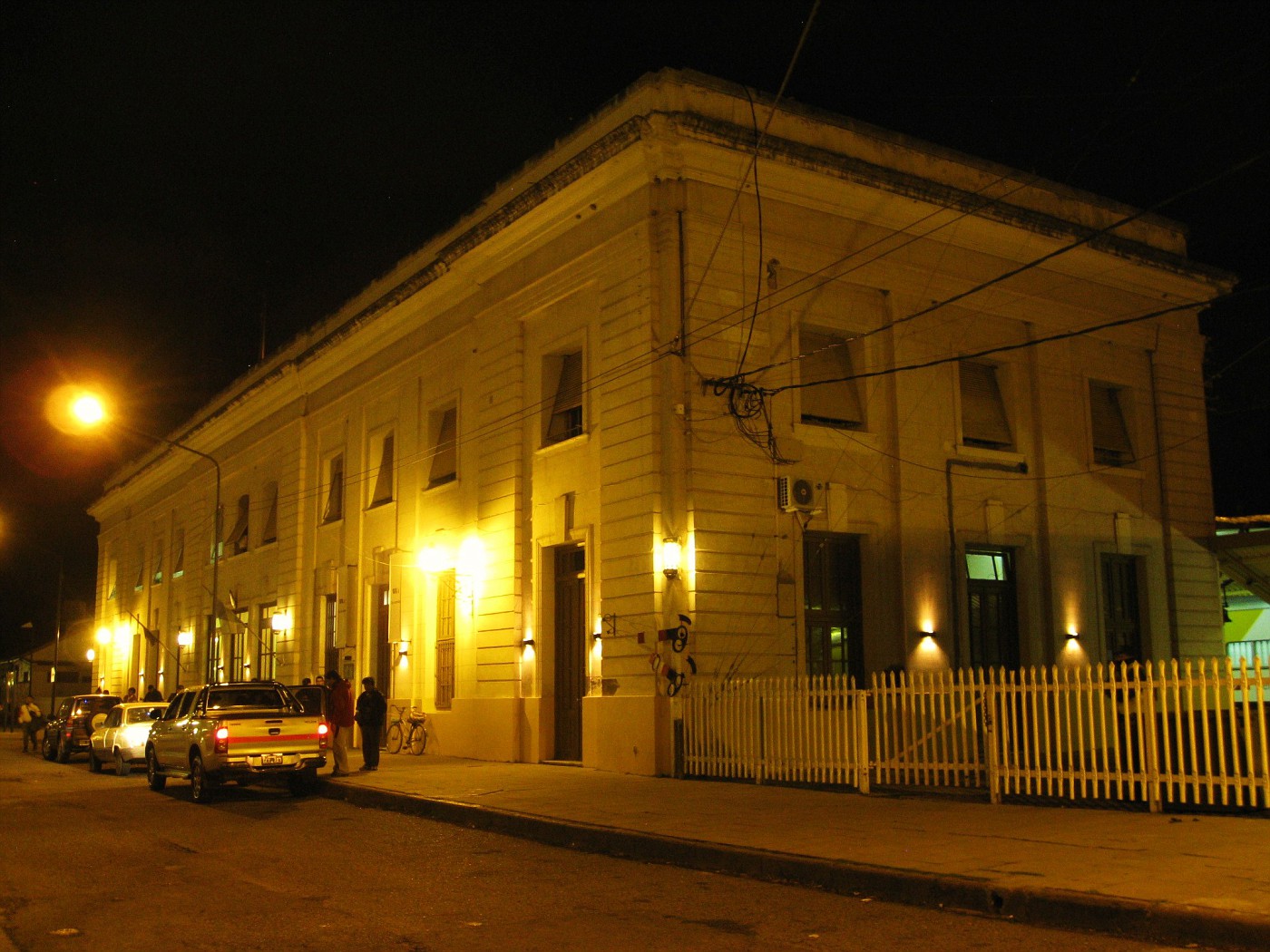 Salta’s General Belgrano Station at 6:30am
Salta’s General Belgrano Station at 6:30am
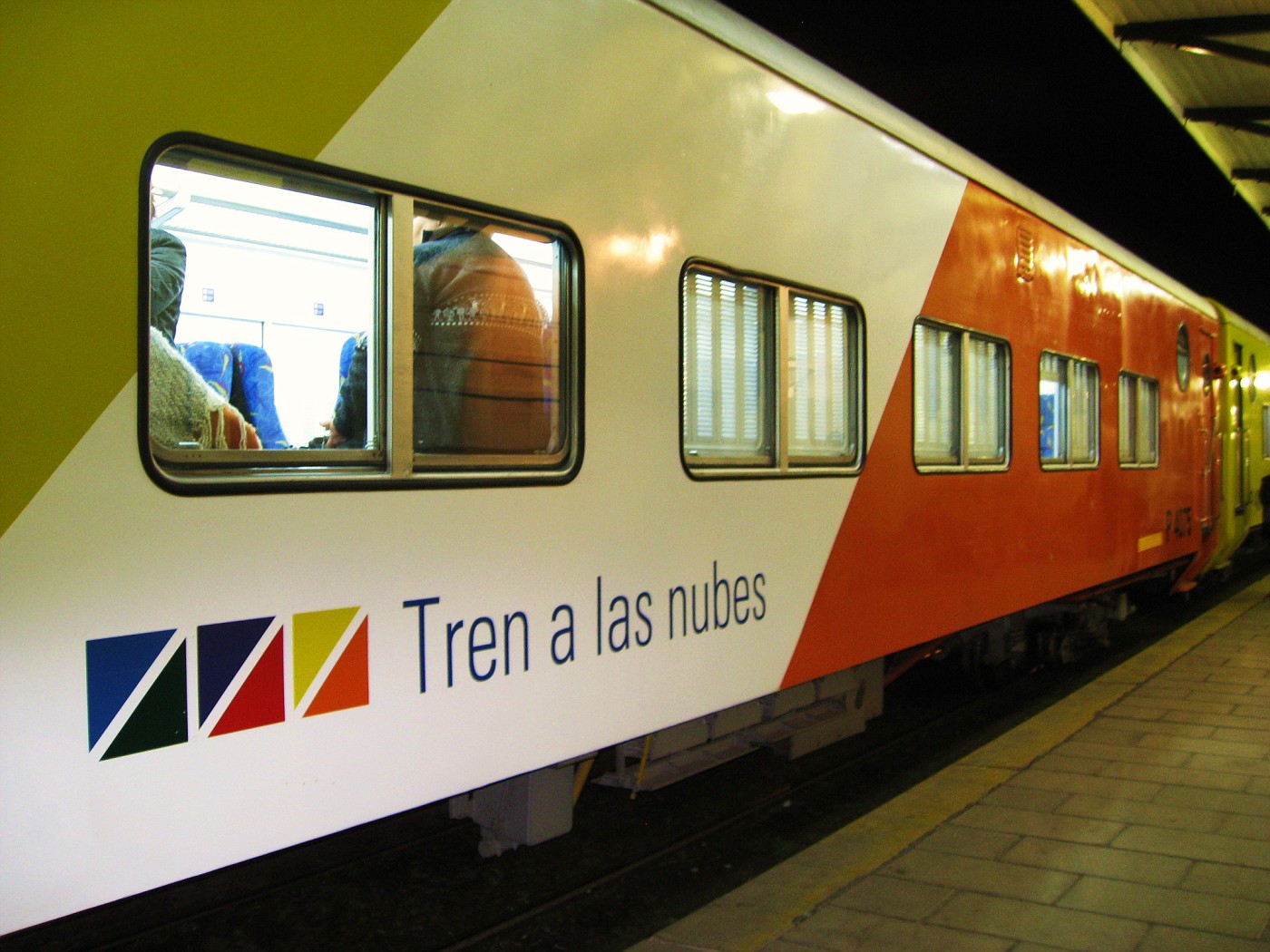 Colorful train cars of Tren A Las Nubes
Colorful train cars of Tren A Las Nubes
Boarding for the 7:05am departure began about 6:45. Judging from language and/or accents around me, my fellow passengers sounded as if they were comprised of every nationality except Argentina. There were a lot of Germans in addition to a large tour group of elderly English travelers. In my car the ladies across from me were from Brazil while the couple behind me were from Canada. Australia and Japan were represented and of course there were a few Americans sprinkled about as well. Over the course of the trip I did meet some Argentines but none of them were from Salta.
Although seats were assigned by number, the seating arrangement in each car was 2-2 with seat pairs facing each other throughout the car. This was great for groups of four and it worked out quite well for me as well since I had a quartet of seats to myself allowing plenty of room to spread out and no competition for the windows.
Speaking of windows, as we pulled out of the station and rolled through the Salta suburbs, the car attendants instructed us to lower the metal window shades throughout the car because children alongside the tracks liked to throw rocks at the windows. Evidently dark windows were less appealing.
An announcement was made providing information about the train and the journey ahead. Please drop what you’re reading and listen up: The total distance to be traveled today is 434km or 270 miles. Travel time will be about 16 hours with a projected return to Salta this evening at 11:00pm. Over the course of the journey we will cross 29 bridges, roll through 21 tunnels and over13 viaducts. As if that weren’t enough, it will also ascend 2 spirals and 2 zigzags. More on zigzags in a bit.
There will be short 20 minute stops at the Polvorilla Viaduct and San Antonio de los Cobres, the highest town in Argentina at 3774 meters or 12,076 feet. The highest elevation reached is 13,845 feet at the Polvorilla Viaduct.
Because of the extreme elevation the train travels through, the journey can be quite literally breathtaking and for that reason a large self-service oxygen tank is available on each rail car. In addition, the train includes a fully staffed medical car should anyone suffer a more serious degree of altitude sickness. As if that weren’t enough precautions, an ambulance would shadow the train on the road that parallels the tracks most of the way up to the Polvorilla viaduct. We were advised that we might minimize the effects of the thin air by drinking plenty of water throughout the trip and keeping movements about the train to a minimum.
To address potential mechanical failures, two service trucks would also accompany the train up to the viaduct and back. In addition, a spare locomotive was available at San Antonio de los Cobres. I was impressed. The train’s new owners would seem to have effectively addressed most any potential mishap, be it medical or mechanical.
A dining car was located at the front of the train. It would be open for lunch and dinner. In between, a small snack bar located one car up would offer packaged snacks and non-alcoholic beverages. In addition, the train staff would provide us with a complimentary breakfast box as well as an afternoon snack.
The breakfast box consisted of – you guessed it - two medialunas and a sweet roll. Since I’d already started the day with some medialunas at my hotel, I settled for a cup of instant coffee.
We came to our first zigzag about two hours into the trip. Zigzags are a most unique way to ascend a mountain via train. Whereas most trains climb via a continual uphill grade, the zigzags allow the train to climb by driving back and forth parallel to the slope of the mountain. Here’s a picture describing the operation:
 Using the Zigzag approach to climbing mountains by rail
Using the Zigzag approach to climbing mountains by rail
As an added bonus, we broke through the clouds shortly after the first zigzag. The majority of our trip was made under bright sunshine prompting more than a couple of people to comment that this train might better be named Train To The Sun.
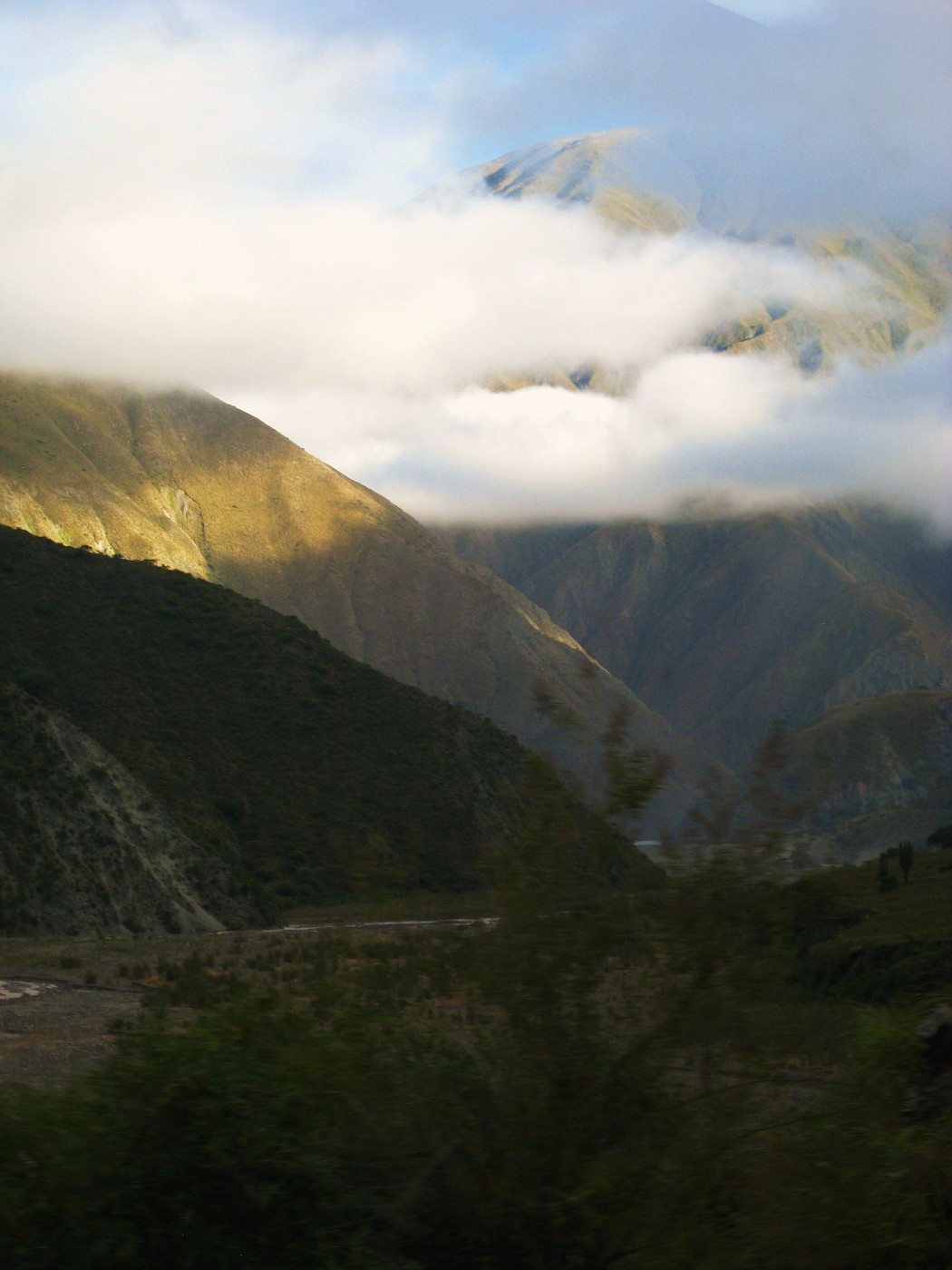 Approaching the clouds
Approaching the clouds
It was interesting to observe the climate zones as we climbed higher and higher into the Andes. Lush green valleys of the Valle de Lerma became the arid cactus strewn gorge known as the Quebrada del Toro. I was particularly impressed by the cactus, similar to the saguaro cactus of the Sonoran Desert but taller and thicker.
 Lush scenery at the lower elevations
Lush scenery at the lower elevations
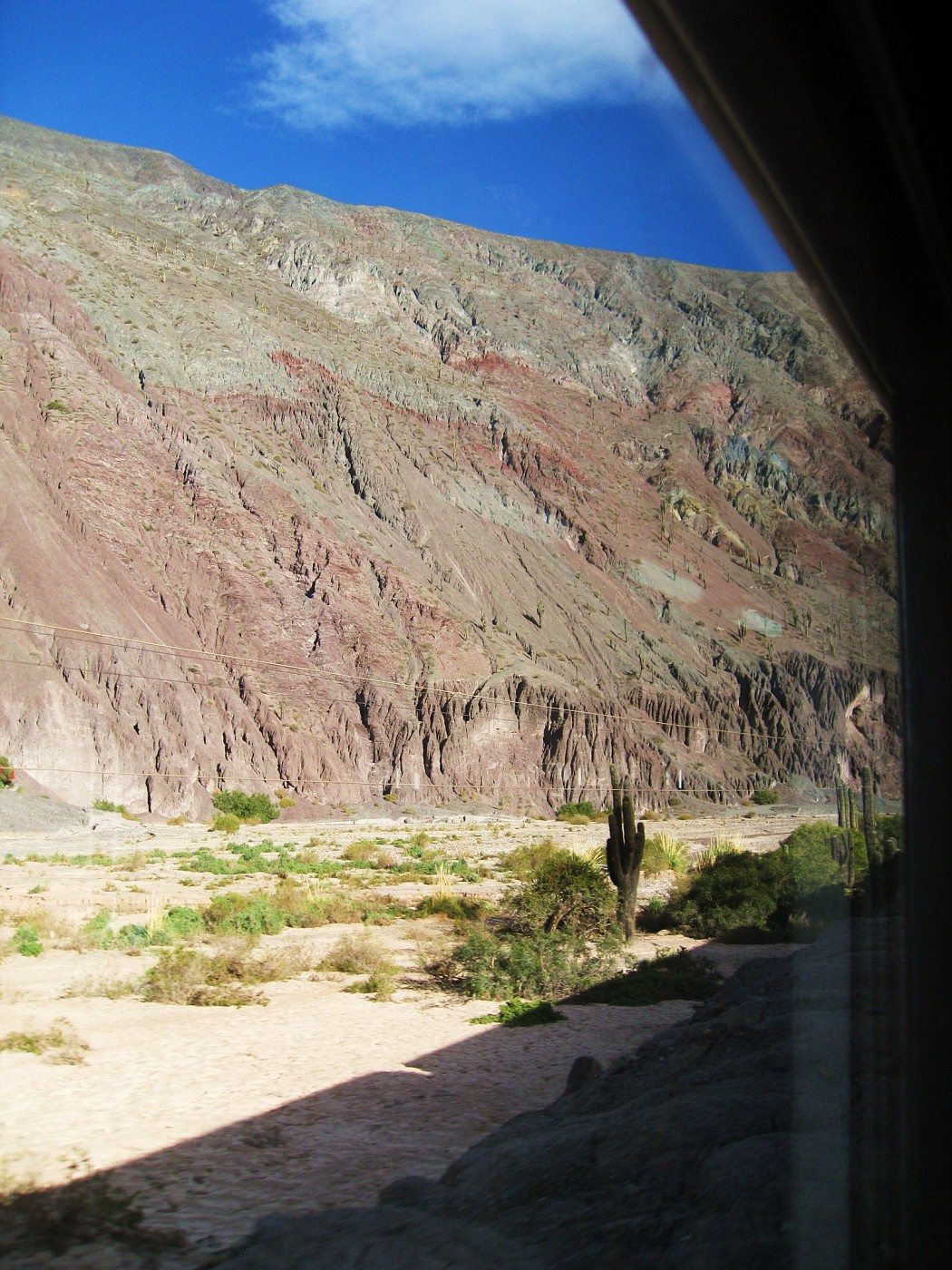 Getting higher and drier
Getting higher and drier
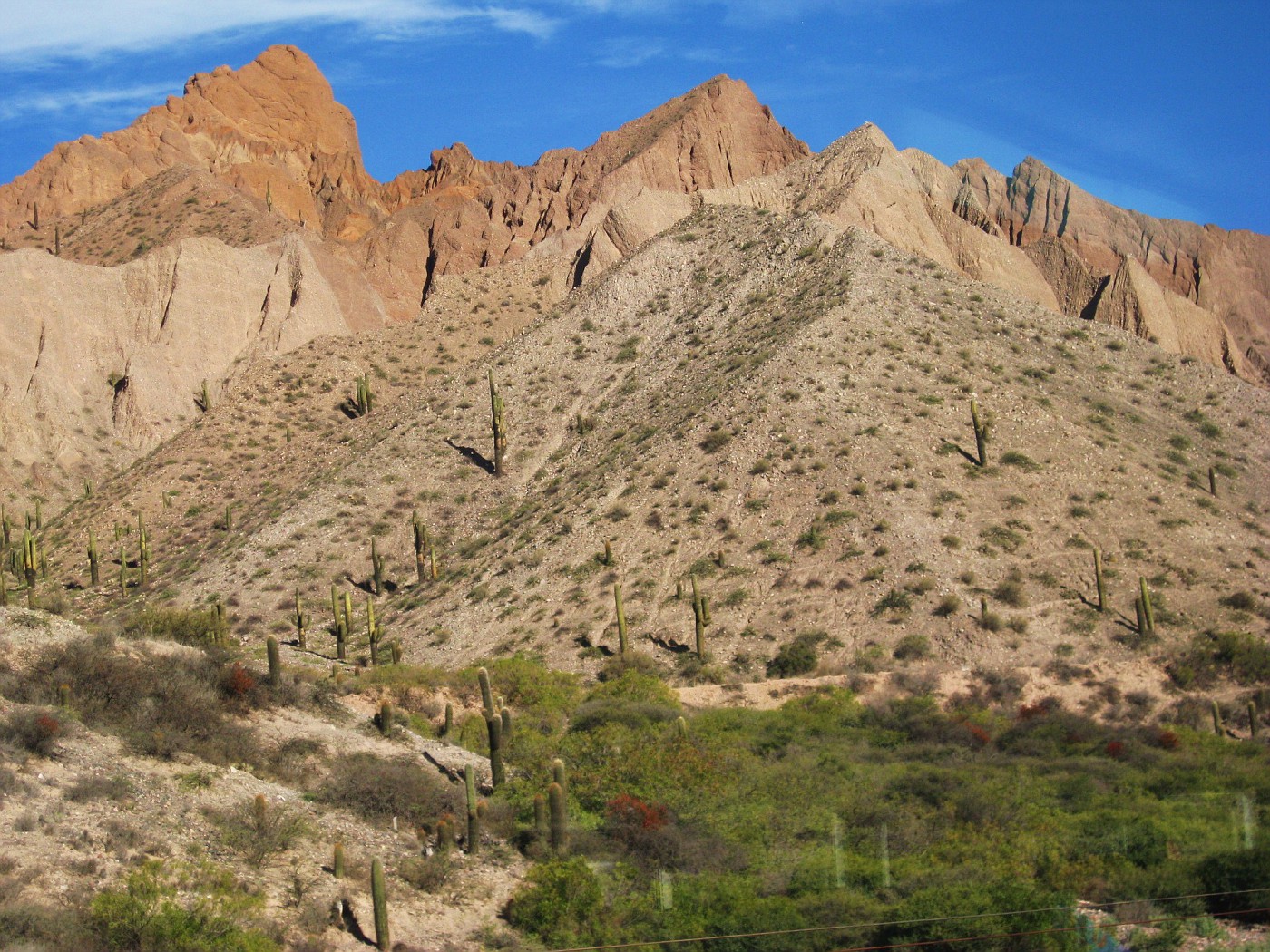 Cactus on the mountainside
Cactus on the mountainside
Colorful rock formations accented the surrounding mountains and wild llamas and alpacas were commonly seen as we climbed above 10000 feet.
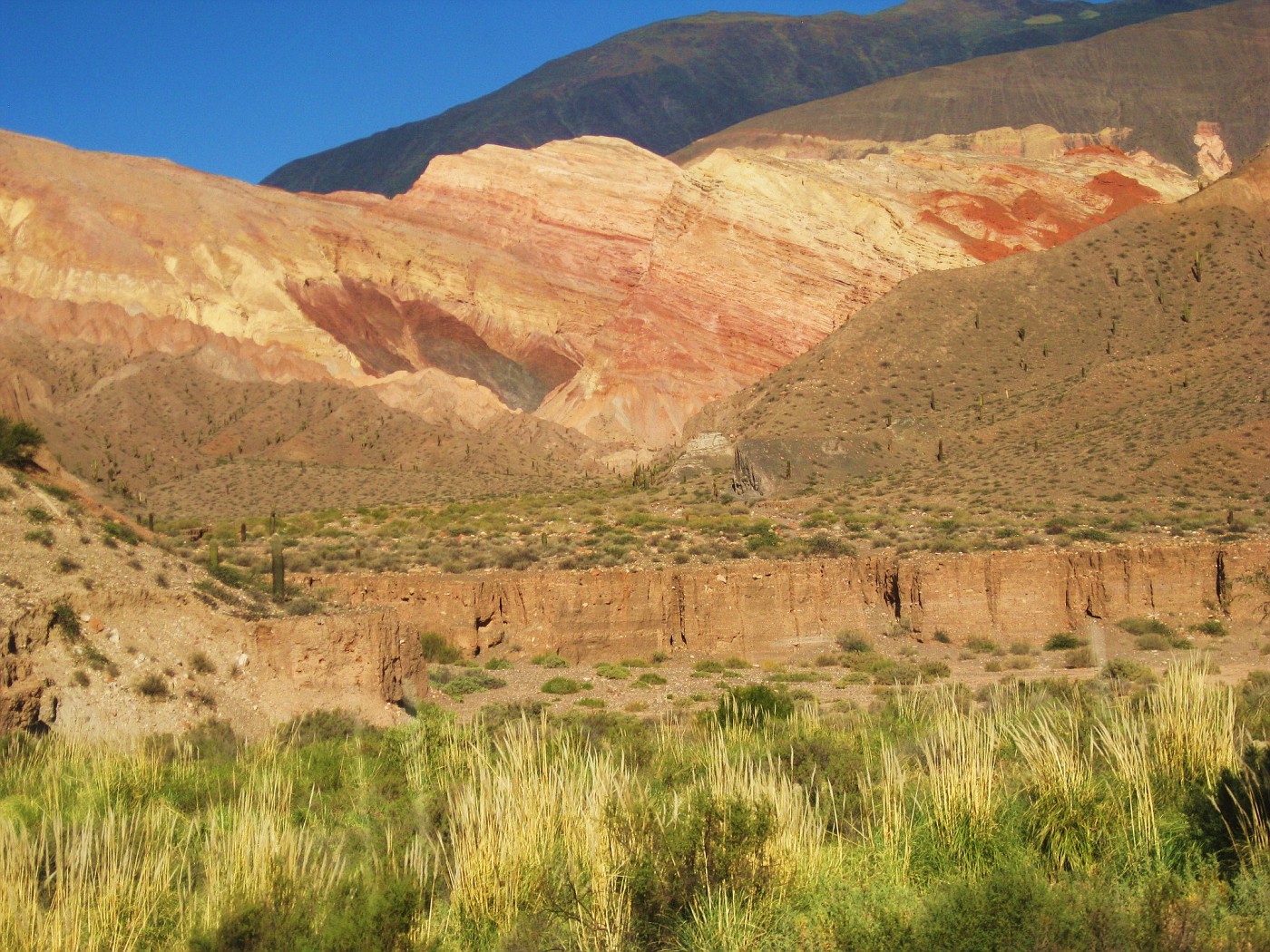 Colorful mountains of the Andes
Colorful mountains of the Andes
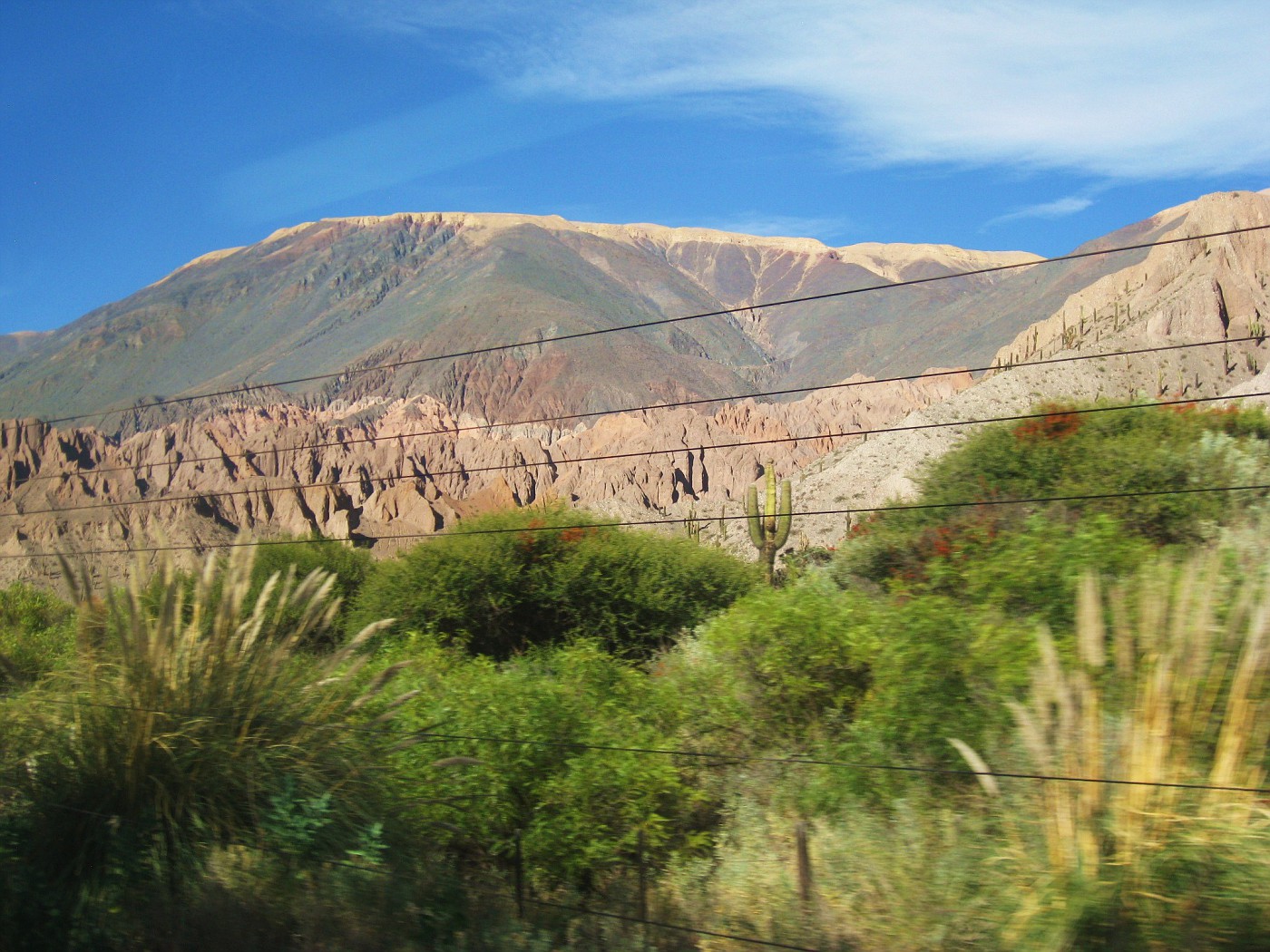 Colorful mountains of the Andes
Colorful mountains of the Andes
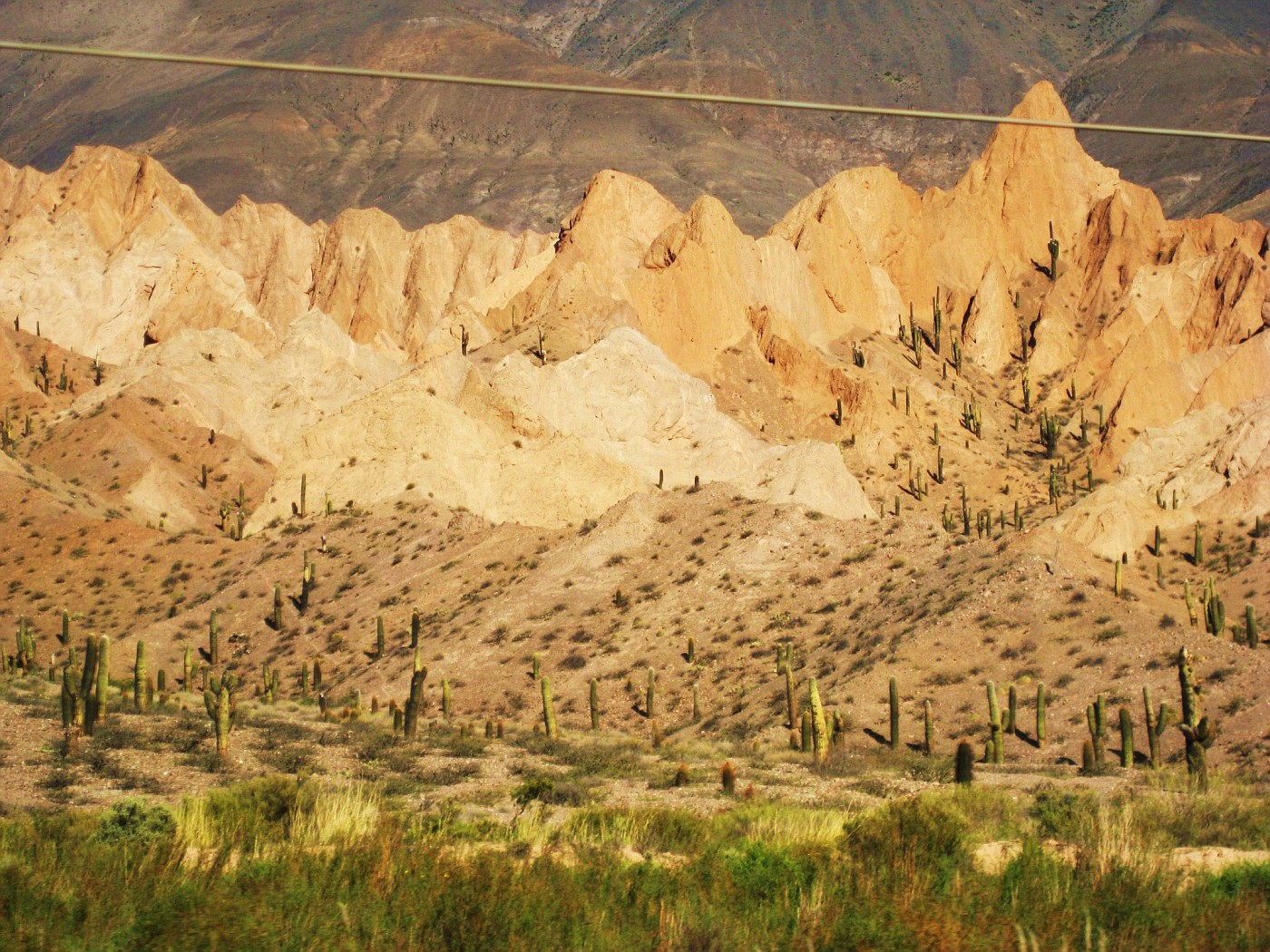 Colorful mountains of the Andes
Colorful mountains of the Andes
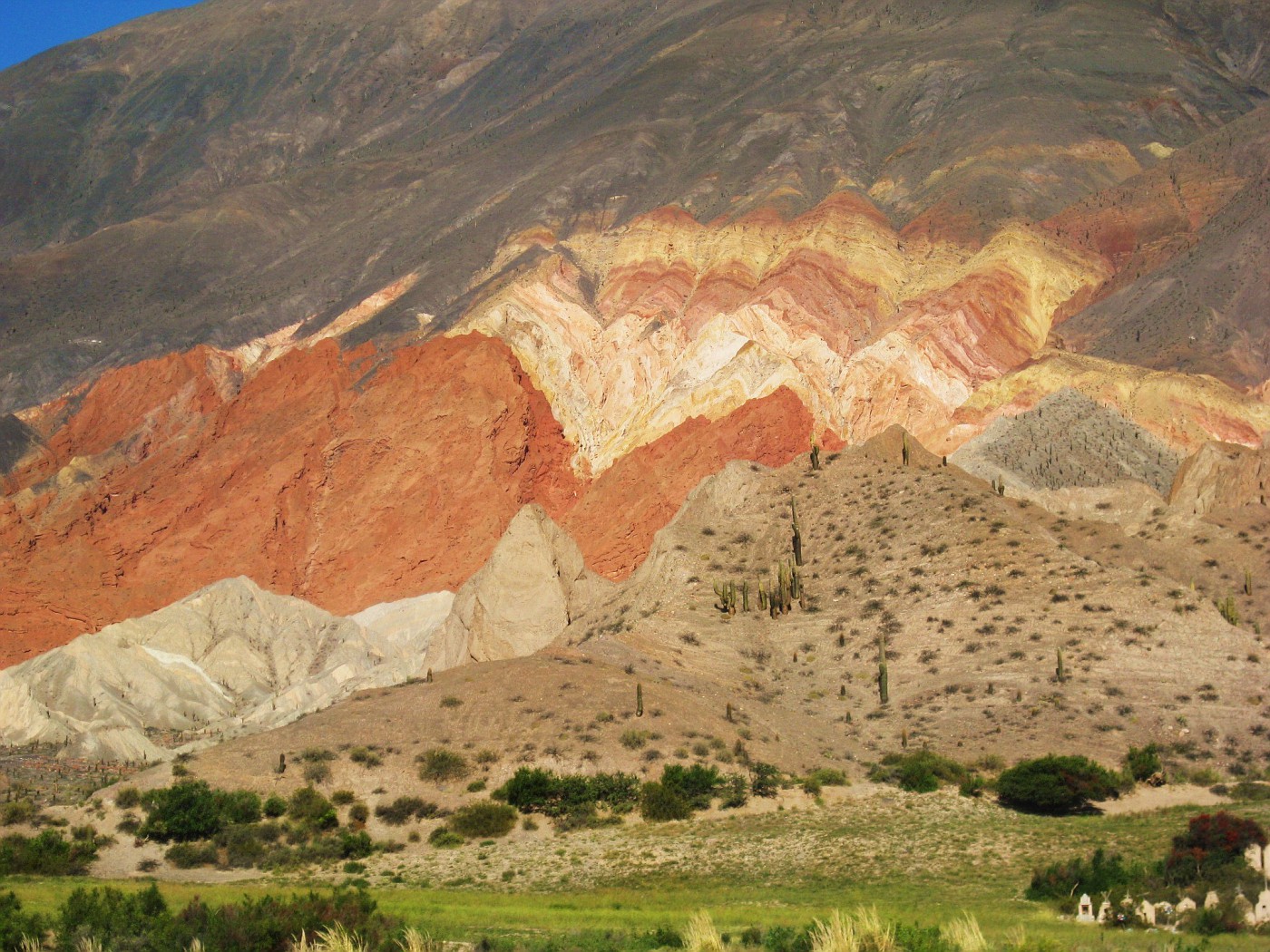 Colorful mountains of the Andes
Colorful mountains of the Andes
The landscape got drier and drier the higher we climbed…
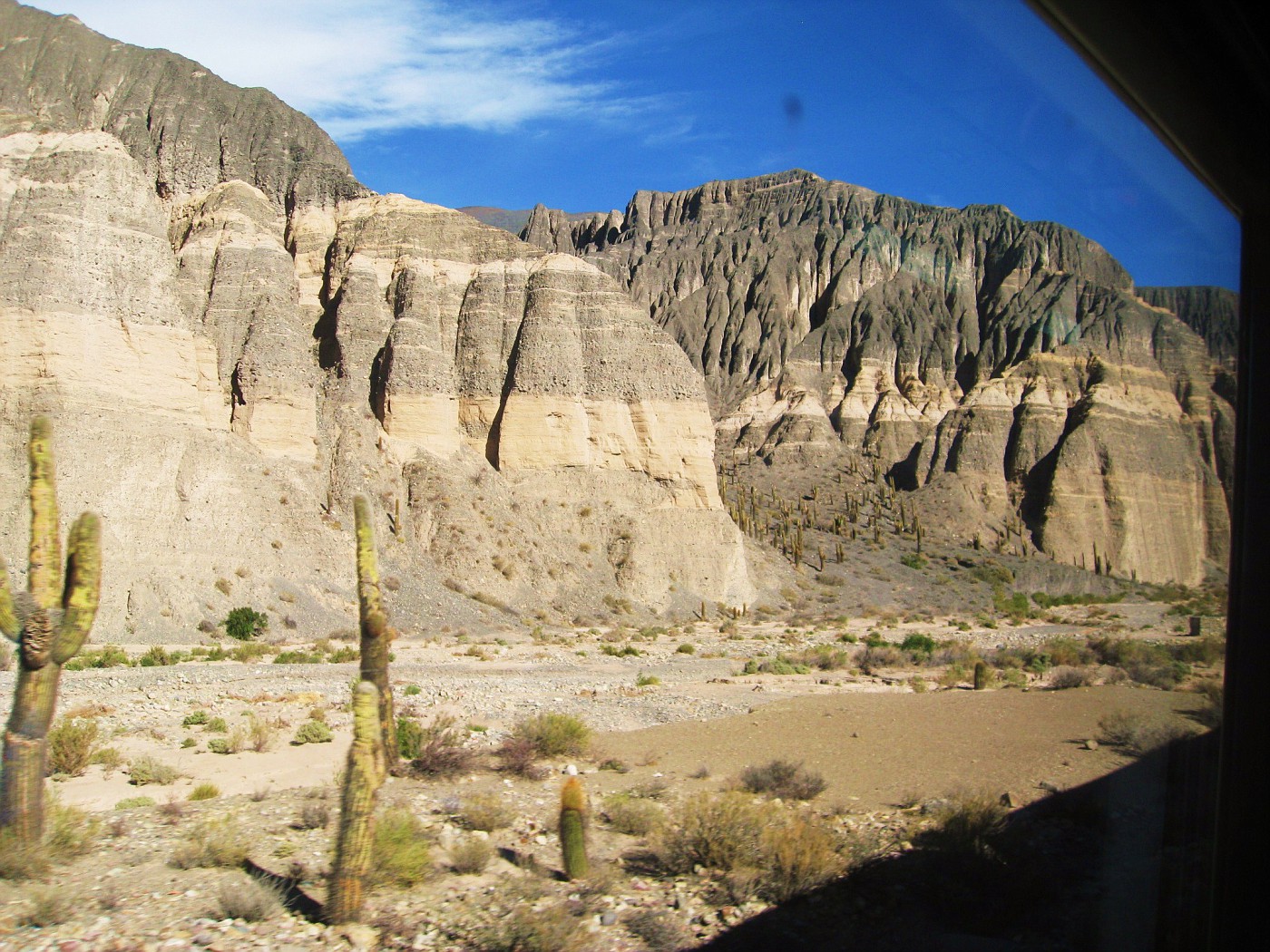 Arid landscape above 10000’
Arid landscape above 10000’
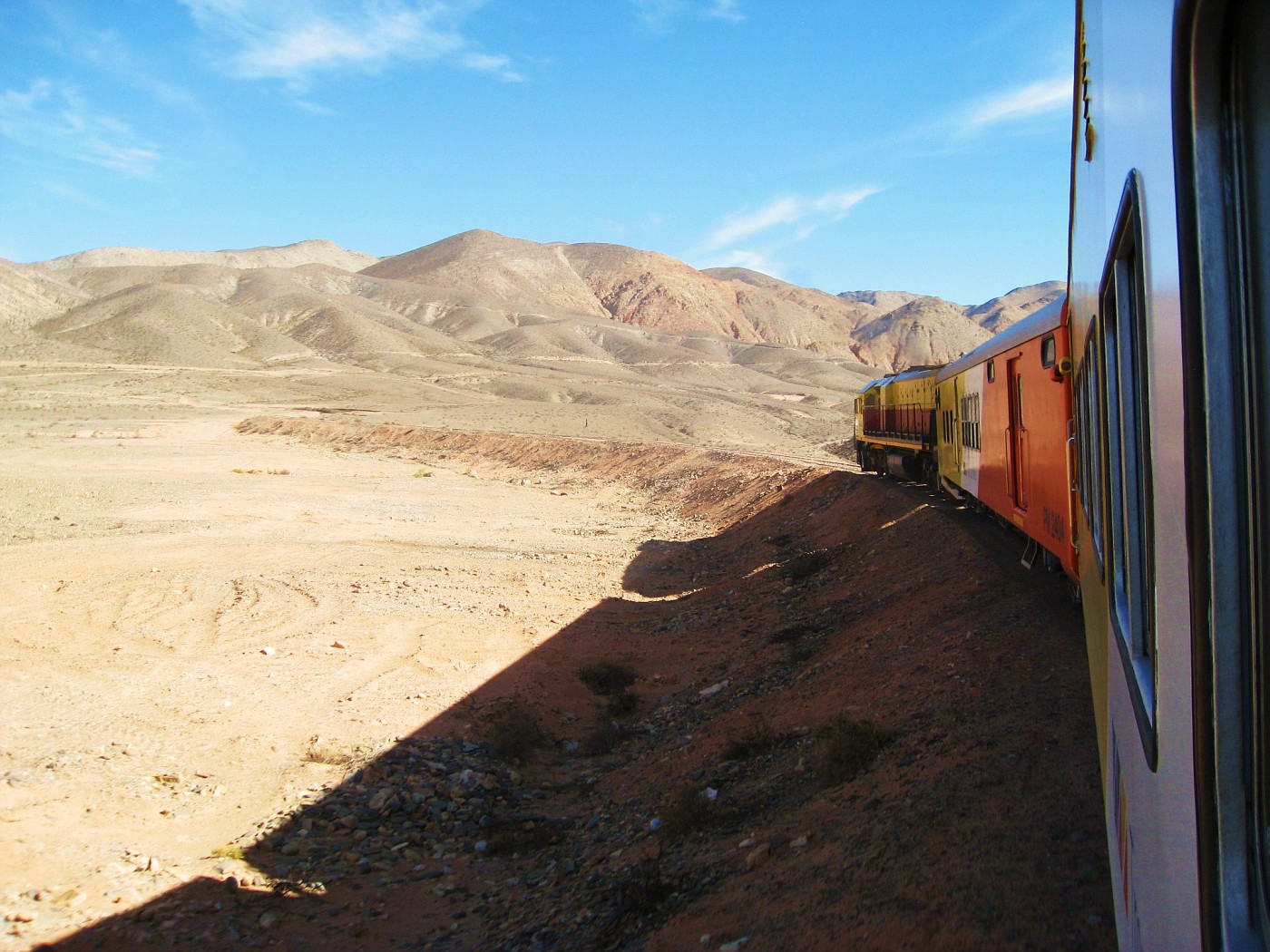 Arid landscape above 10000’
Arid landscape above 10000’
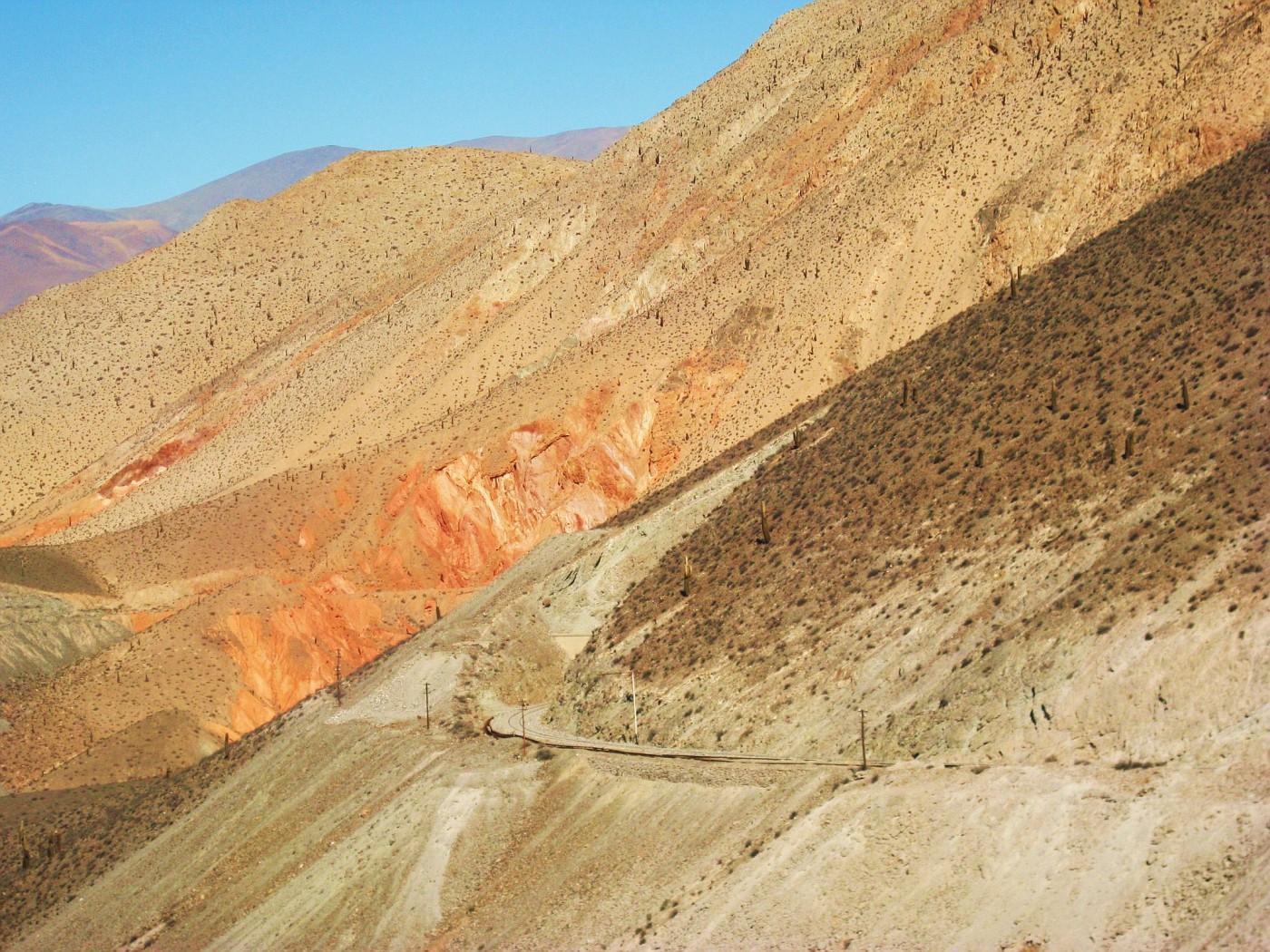 Arid landscape above 10000’
Arid landscape above 10000’
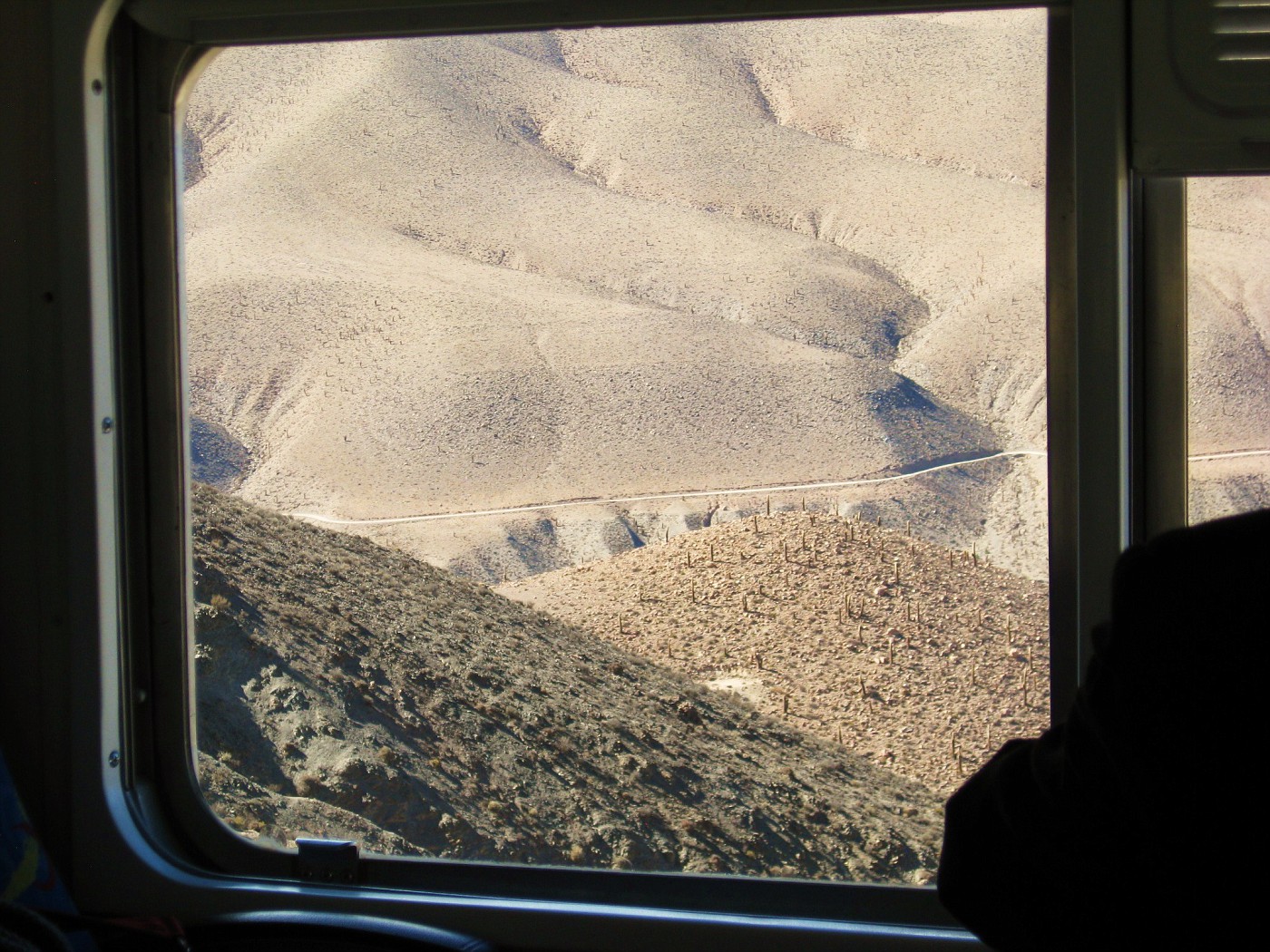 Climbing Higher
Climbing Higher
I should mention here that our two car attendants also provided excellent commentary throughout the trip (in both English and Spanish) about the lands, towns, cultures and history of the areas that we passed through.
Luncheon was by reservation so I signed up for the 1:00pm seating. Two main courses were offered at the time reservations were made. I believe the choices were chicken or beef but I can say for sure that I ordered the chicken. The price for either entrée was $65.00 Argentinean Pesos, or about $17.50 USD. This was extremely expensive by Argentinean standards but I’ve got this thing about train travel wherein I feel that a proper journey should include at least one meal in the diner.
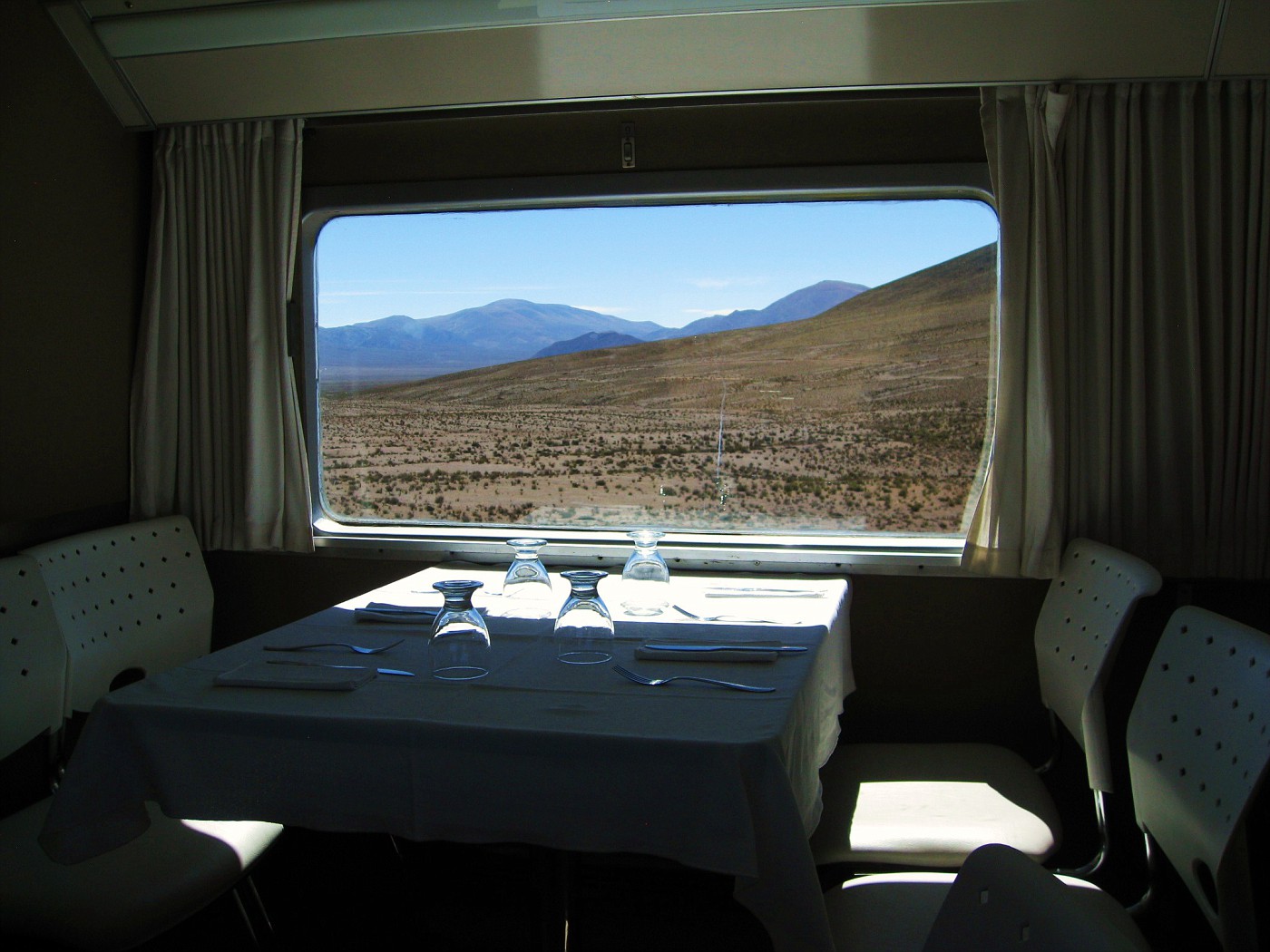 A view of the altiplano from the diner – elevation approximately 12000’
A view of the altiplano from the diner – elevation approximately 12000’
At 1:00pm I made my way up to the diner and was assigned a table to myself. Seating was communal so I assumed that I would eventually have company but none ever arrived. In fact, for the 1:00 seating at least, the diner was never more than about half full. Perhaps the expensive prices scared off some of the passengers who would instead have the option of buying local fare from the townspeople during our brief stop in San Antonio de los Cobres.
The dining car was operated by a local Salta restaurant. A waiter stopped by to take my drink order while also delivering a coupon good for 20% discount should I visit the restaurant. I requested a can of Salta beer, a fairly decent lager when served cold. Unfortunately, my can arrived at room temperature. What is it with South American trains and warm beer? Most restaurants will serve you a properly chilled beer but somehow this protocol is mysteriously lost on railroad dining car staffs. The worst offender was the Chilean National Railway. Back in the early 1990s, I was riding a long since discontinued overnight train between Santiago and Puerto Montt. When the beverage cart was rolled through our sleeper accommodations, I requested a beer and was presented with a bottle that was downright hot. It turned out that all of the beverages had been stored in the kitchen where the ambient temperature was about 90°F. Although ice was available on board, there was only enough to use for cocktails, not chill beer. I switched to Pisco Sours for that ride until a lengthy stop in Concepcion allowed us to purchase a block of ice at a nearby store.
Getting back on track however, I will say that the meal I was served on this train - a stuffed chicken roll with rice and ratatouille – was quite good. In most Salta restaurants this meal would have cost no more than about $8.00 and had the prices been more reasonable I would have taken dinner in the diner as well. Alas, because I must spread my financial resources out over two months and six continents, I was forced to exercise restraint.
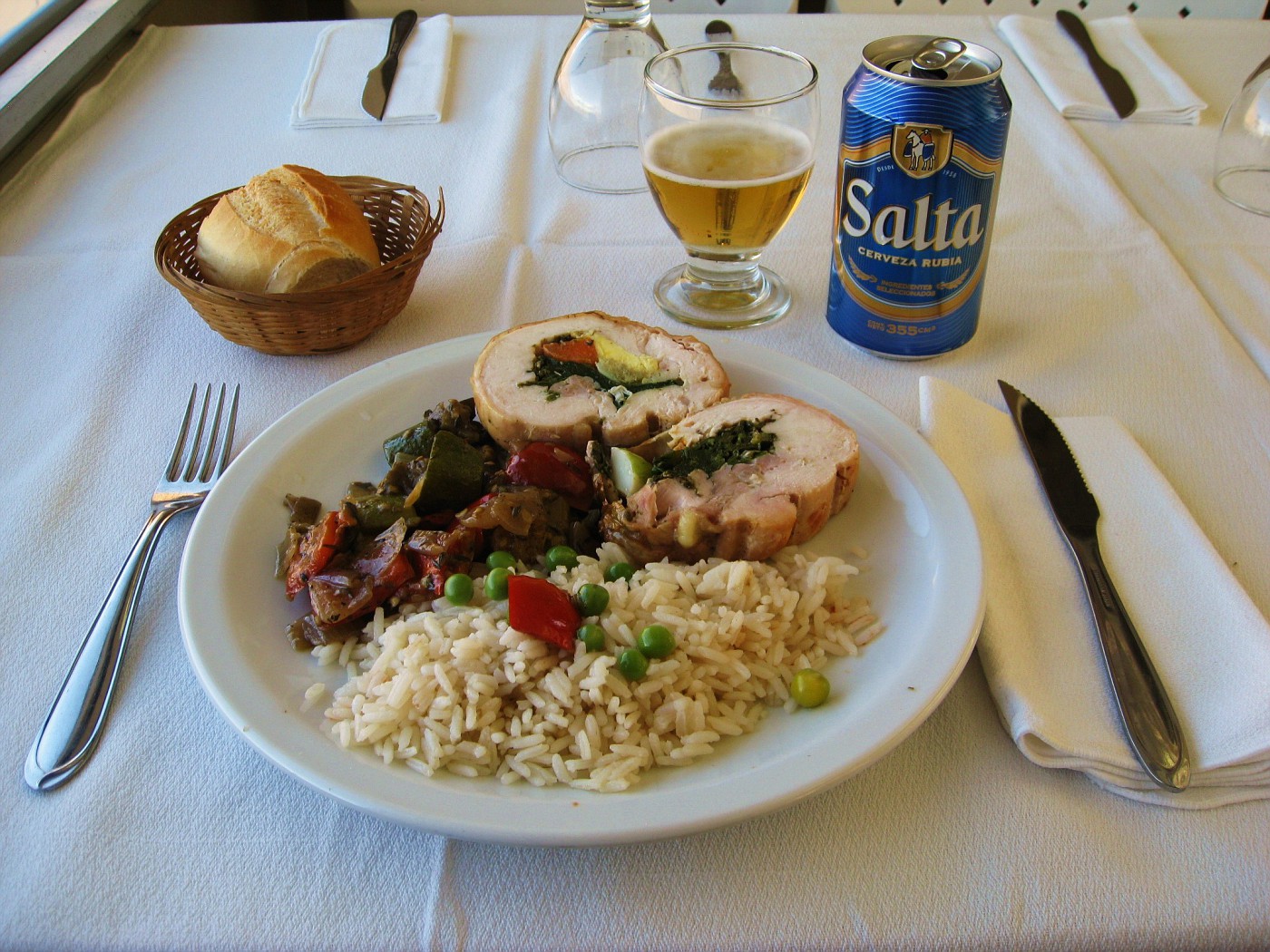 Chicken lunch in the dining car
Chicken lunch in the dining car
Soon after I finished lunch, the train stopped just past San Antonio de los Cobres so that we could switch the engine from the front of the train to the back. The result was that we’d be pushed rather than pulled up to the Polvorilla Viaduct. There was no place up there to turn the train around and for the relatively steep downhill grade back to San Antonio, it made good sense to have the locomotive up front in a position to control our downhill speed than at the back of the train where that task would be decidedly more difficult.
The Polvorilla Viaduct is impressive. It’s 700 feet long and just over 220 feet high. We were pushed all the way across the viaduct before slowly proceeding forward to a wide area at one end of the viaduct where local villagers awaited our arrival with a variety of crafts and clothing for sale. As I stepped off the train, I was indeed feeling a bit lightheaded but otherwise pretty good. Not everyone fared so well though. On the return trip down to San Antonio, one of the Brazilian ladies fainted and fell right in the aisle beside her seat. Medical staff were quick to respond and she was revived on the spot with smelling salts before being taken back to the medical car. She returned about a half hour later apparently no worse for the wear. A number of other people also made visits to the medical car where beds and oxygen were available until they felt better. Thankfully nobody had need of the ambulance.
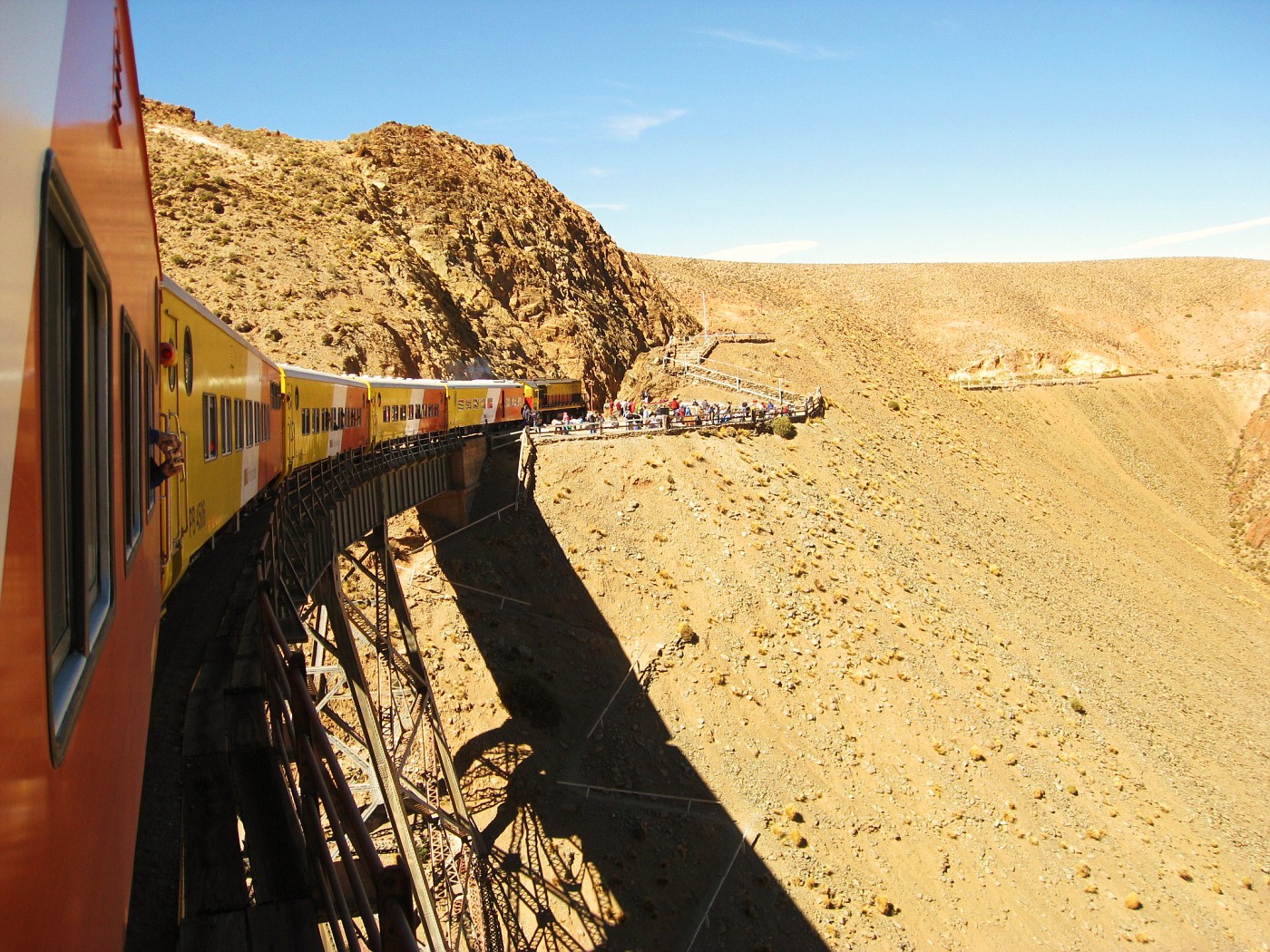 La Polvorilla Viaduct
La Polvorilla Viaduct
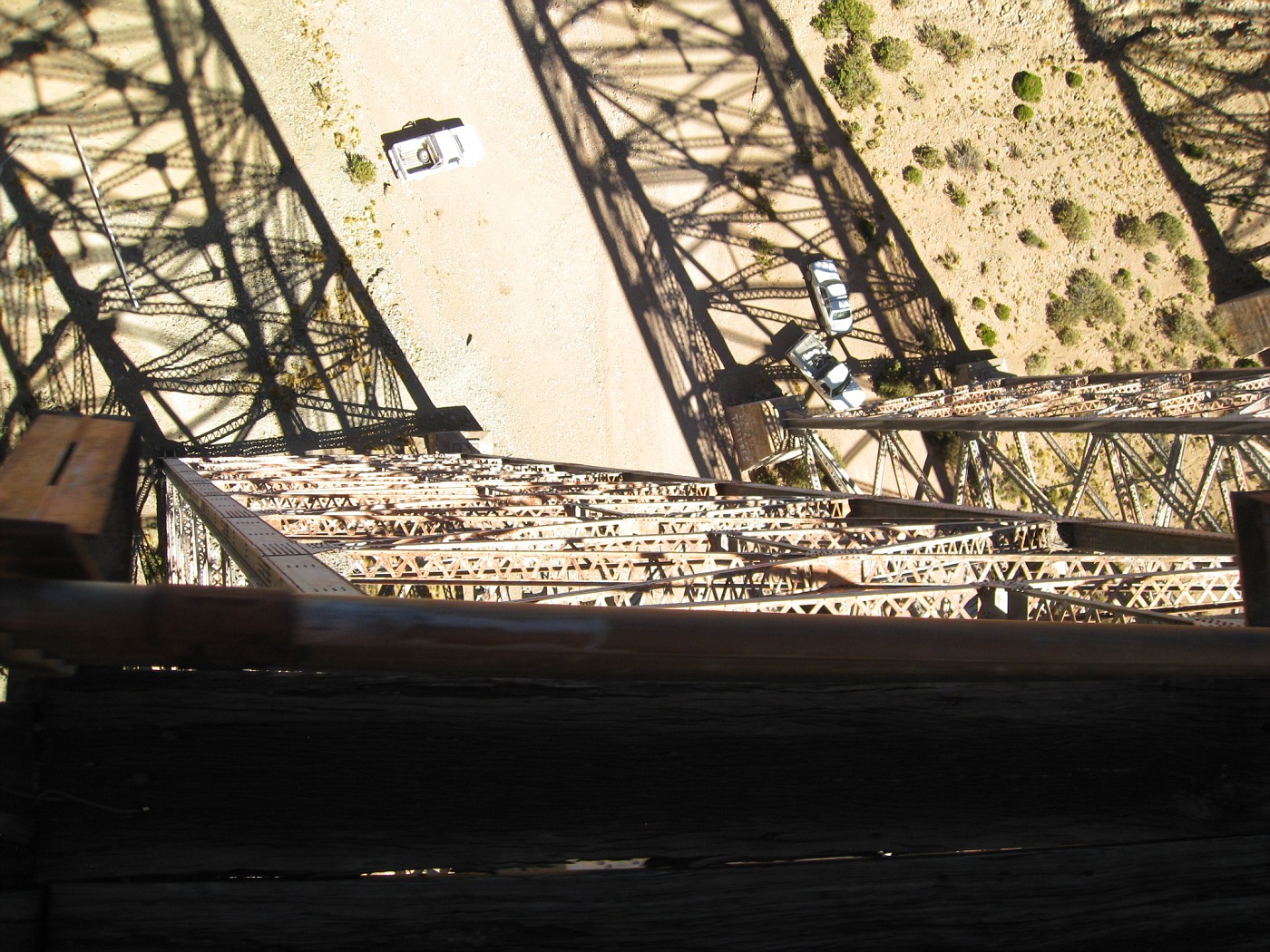 Don’t look down (234 feet below)
Don’t look down (234 feet below)
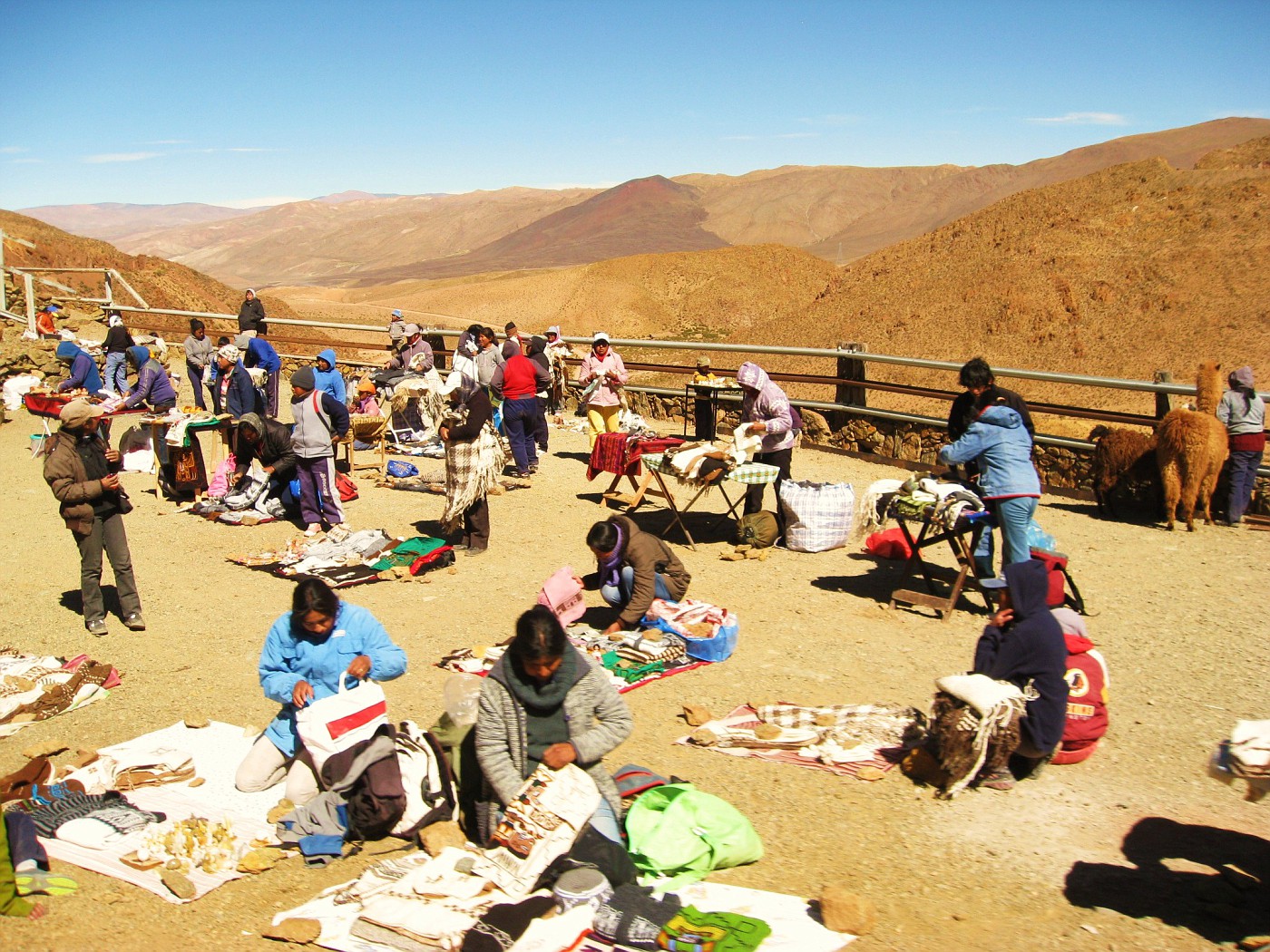 How much for those llamas over against the wall?
How much for those llamas over against the wall?
In San Antonio de los Cobres, we stopped once again for about a half hour. The villagers awaiting us not only had crafts and clothing for sale, they also had food. By the way, Cobres means copper, the mining of which is the principal employment in this town of about 5000.
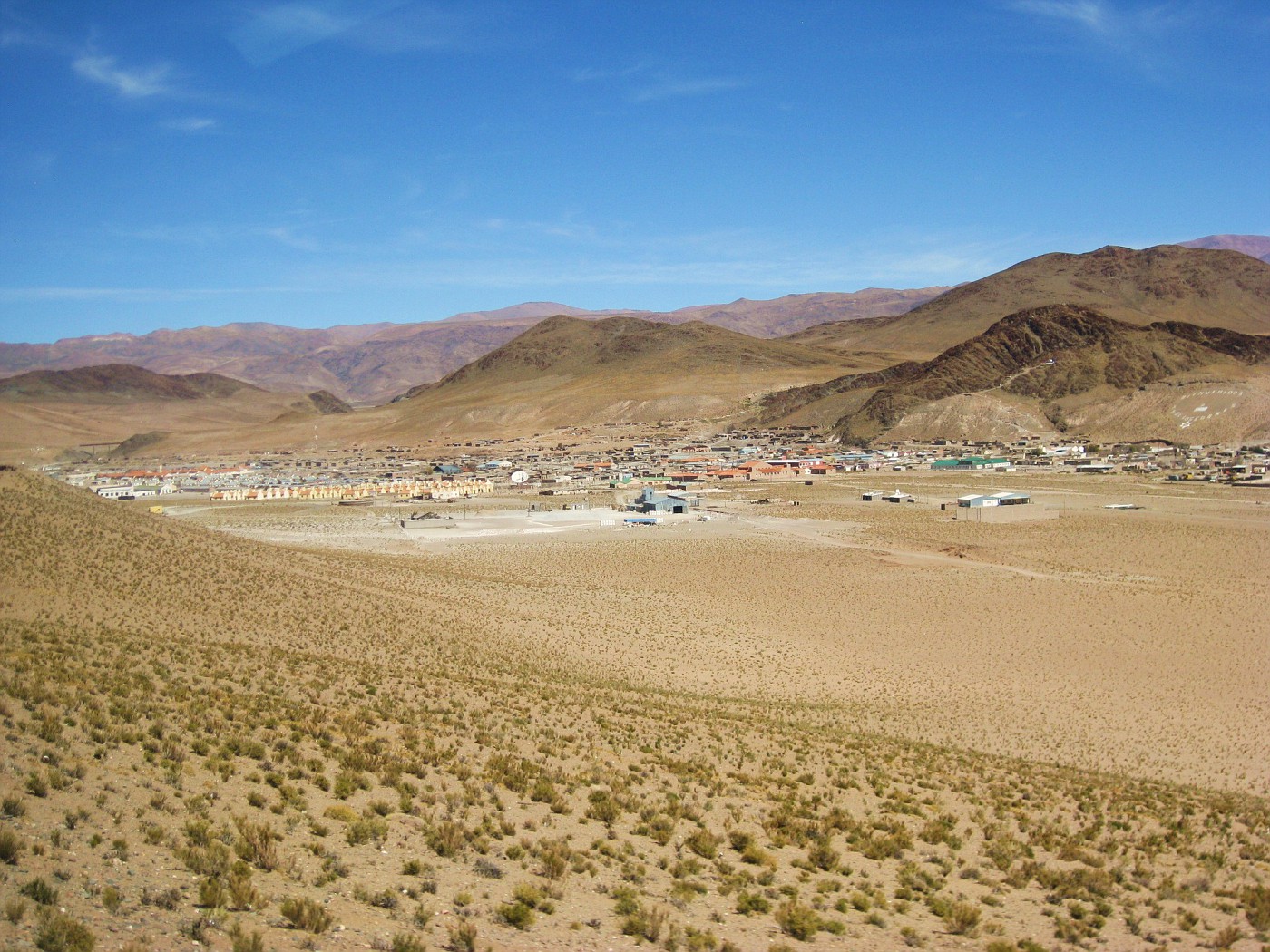 San Antonio de los Cobres – the highest town in Argentina
San Antonio de los Cobres – the highest town in Argentina
 The station at San Antonio de los Cobres
The station at San Antonio de los Cobres
By the time we departed San Antonio it was nearly 5:00pm. It had been a long day so far and there were still another six hours to go. The trip back down to Salta was scenic but otherwise non-eventful. A snack box was distributed around 6. I was hoping for a ham and cheese sandwich but instead received a nicely decorated box filled with cookies and other breaded sweets. With all this sugar and carbohydrates to snack on, I wouldn’t be surprised if diabetes is a problem in Argentina. As for me I’d had enough sugary stuff for the day and was thankful that I’d thought to bring along a big bag of almonds and an apple. Without dinner in the diner, that’s all I had to get me back to Salta.
About an hour and a half out of Salta, some local musicians boarded our car and entertained us with live Argentinean folk music. Lots of accordion, guitar strumming and good singing. There was even some dancing in the aisles!
The window shades went back down about a half hour before our arrival in Salta and we were then presented with certificates indicating our passage aboard the highest railroad in Argentina. This was done individually with each recipient’s home country announced as well. Every presentation garnered lots of applause from the surrounding passengers. When we pulled into Salta’s General Belgrano Station at 11:00pm, our attendants saw us off at the door, thanking each of us for riding the Tren A Las Nubes.
Overall, this was an excellent train ride, very well organized and well operated by Ecotren. The onboard staff were excellent throughout the journey and the dining car, while expensive, provided a delicious meal. To anyone traveling to northern Argentina in search of a scenic and entertaining day trip, I highly recommend the Tren A Las Nubes.